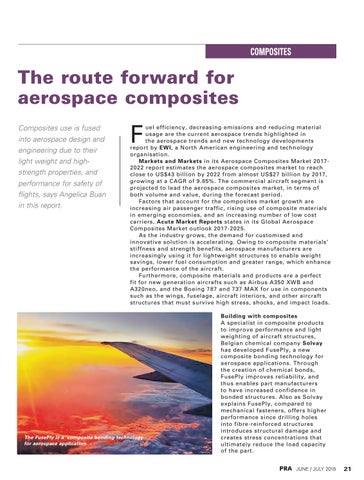Composites
The route forward for aerospace composites Composites use is fused into aerospace design and engineering due to their light weight and highstrength properties, and performance for safety of flights, says Angelica Buan in this report.
F
uel efficiency, decreasing emissions and reducing material usage are the current aerospace trends highlighted in the aerospace trends and new technology developments report by EWI, a North American engineering and technology organisation. Markets and Markets in its Aerospace Composites Market 20172022 report estimates the aerospace composites market to reach close to US$43 billion by 2022 from almost US$27 billion by 2017, growing at a CAGR of 9.85%. The commercial aircraft segment is projected to lead the aerospace composites market, in terms of both volume and value, during the forecast period. Factors that account for the composites market growth are increasing air passenger traffic, rising use of composite materials in emerging economies, and an increasing number of low cost carriers, Acute Market Reports states in its Global Aerospace Composites Market outlook 2017-2025. As the industry grows, the demand for customised and innovative solution is accelerating. Owing to composite materials’ stiffness and strength benefits, aerospace manufacturers are increasingly using it for lightweight structures to enable weight savings, lower fuel consumption and greater range, which enhance the performance of the aircraft. Furthermore, composite materials and products are a perfect fit for new generation aircrafts such as Airbus A350 XWB and A320neo, and the Boeing 787 and 737 MAX for use in components such as the wings, fuselage, aircraft interiors, and other aircraft structures that must survive high stress, shocks, and impact loads.
The FusePly is a composite bonding technology for aerospace application
Building with composites A specialist in composite products to improve performance and light weighting of aircraft structures, Belgian chemical company Solvay has developed FusePly, a new composite bonding technology for aerospace applications. Through the creation of chemical bonds, FusePly improves reliability, and thus enables part manufacturers to have increased confidence in bonded structures. Also as Solvay explains FusePly, compared to mechanical fasteners, offers higher performance since drilling holes into fibre-reinforced structures introduces structural damage and creates stress concentrations that ultimately reduce the load capacity of the part. JUNE / JULY 2018
21
